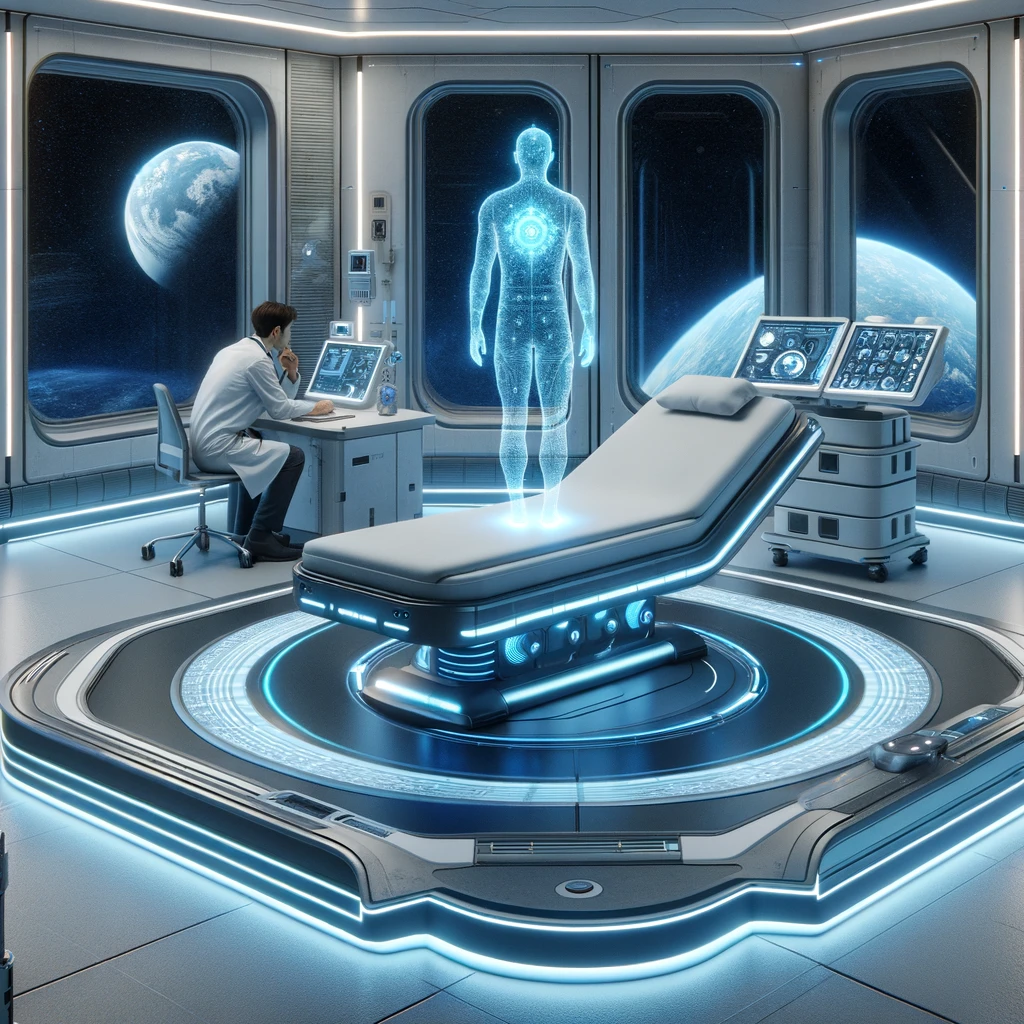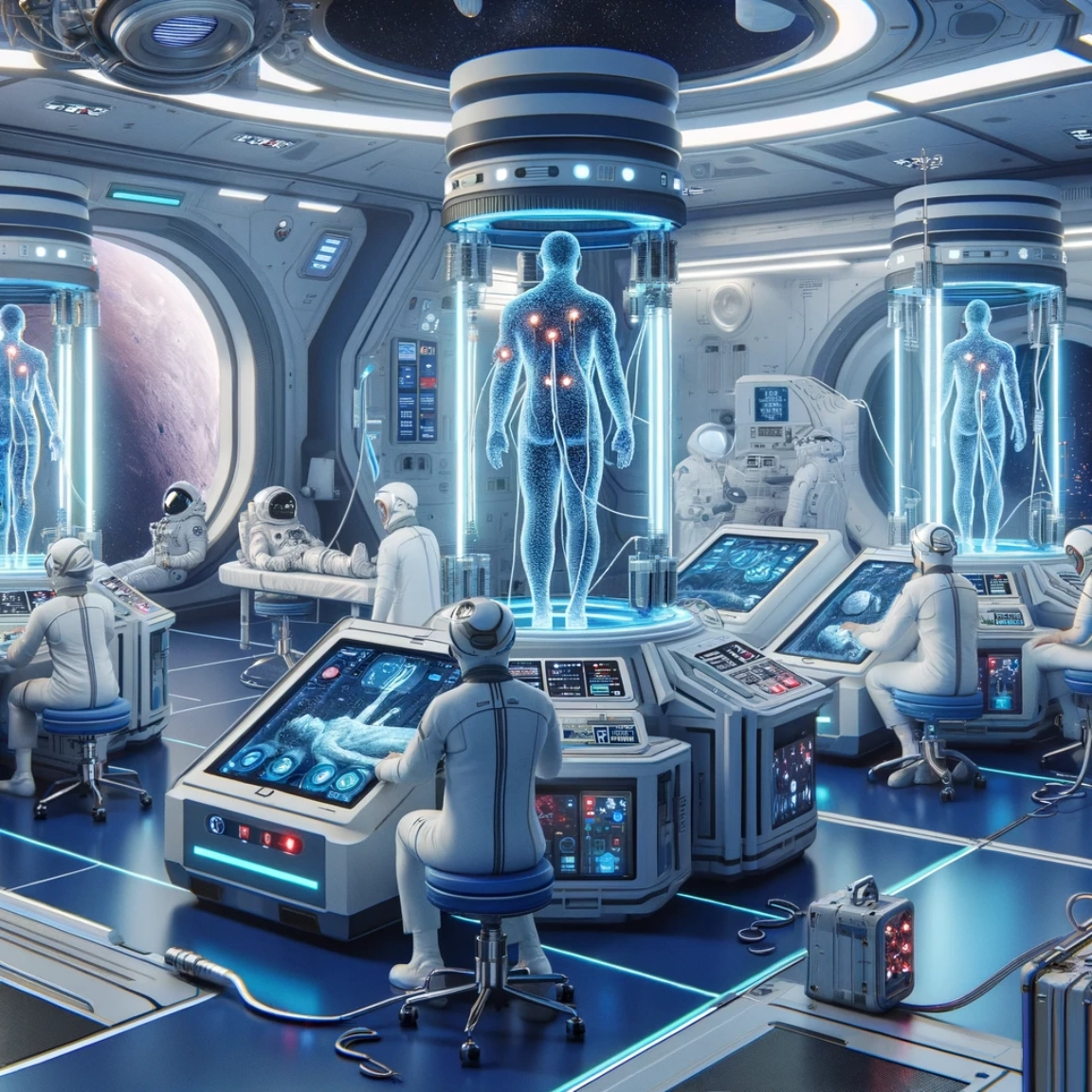Electrotherapy for Space Astronauts (ESA) in Microgravity
Electrostimulation in astronauts (EsA) is an approach that should be a space research grant also with the European Space Agency (ESA) to address the unique challenges facing astronauts in a microgravity environment. Electrotherapy for space astronauts aims to mitigate the detrimental effects of prolonged weightlessness on muscle and bone density. In the absence of gravity, astronauts experience significant muscle atrophy and bone loss, which can impair their physical performance and overall health. EsA leverages targeted electrical impulses to stimulate muscle contractions, thereby maintaining muscle strength and preventing atrophy. This innovative technique not only helps in preserving astronauts’ physical fitness during extended missions but also facilitates their rehabilitation upon return to Earth. Through rigorous research and application, the ESA continues to explore and enhance electrostimulation protocols to ensure the well-being and operational efficiency of astronauts in the demanding conditions of space.
Table of Contents
The Application of Electrotherapy in Space: Enhancing Astronaut Health Under Microgravity Conditions
Introduction
Space missions present unique challenges to human physiology, primarily due to the effects of microgravity. These effects include muscle atrophy, bone density loss, and various changes in bodily fluids. Addressing these challenges is crucial for the health and performance of astronauts during and after their missions. One of the innovative approaches to mitigating these effects is the use of electrotherapy.
What is Electrotherapy?
Electrotherapy involves the use of electrical energy as a medical treatment, which includes a variety of treatments using electricity to reduce pain, improve circulation, repair tissues, strengthen muscles, and promote bone growth, among other benefits. This therapeutic method has been adapted for use in space, tailored to counteract the musculoskeletal and circulatory issues caused by prolonged periods in microgravity.
Electrotherapy in Microgravity: The ESA Approach
The European Space Agency (ESA) has been at the forefront of integrating electrotherapy techniques into astronaut health regimes. Studies have shown that pulsed electric fields can help manage and reduce muscle atrophy and bone density loss—two significant concerns for astronauts during long-term space missions.
Applications in Space
- Muscle Stimulation:
- Electrotherapy can be used to stimulate muscle contractions, helping maintain muscle tone and strength without the need for heavy physical weights, which are impractical in a microgravity environment.
- Pain Relief:
- Astronauts often experience back pain from spinal elongation in microgravity. Electrotherapy can alleviate this pain by stimulating nerves and reducing inflammation.
- Bone Density Maintenance:
- The application of specific electric currents has been shown to promote bone density and help prevent the severe bone loss that astronauts suffer during longer missions.
Benefits of Electrotherapy in Space
The integration of electrotherapy into space missions offers several benefits, making it a critical component of health maintenance for astronauts:
- Efficiency: It provides targeted treatments with minimal need for physical exertion, conserving energy that astronauts can use for other tasks.
- Safety: It reduces the risk of injury that might come from more traditional forms of exercise under altered gravity conditions.
- Versatility: Different settings and programs can be used to target specific conditions and needs, making it a versatile tool for space health management.
Future Directions
Research continues to evolve, with ongoing studies aimed at optimizing electrotherapy settings and protocols to improve its efficacy in space. Collaborations between space agencies and biomedical research institutions are key to advancing this technology. The future may see the development of wearable electrotherapy devices, which could provide continuous therapy as astronauts carry out their daily tasks.
Conclusion
Electrotherapy represents a significant advancement in the maintenance of astronaut health in microgravity. By addressing the muscular and skeletal challenges posed by space travel, this technology plays a crucial role in current and future missions, ensuring that astronauts not only survive but thrive in the environment of space. Further research and development will enhance its effectiveness and integration into even longer space missions, potentially to Mars and beyond.
References
- Lastauskienė, E., Novickij, V., Zinkevičienė, A., Girkontaitė, I., Paškevičius, A., Švedienė, J., Markovskaja, S., & Novickij, J. (2018). Application of pulsed electric fields for the elimination of highly drug-resistant Candida grown under modelled microgravity conditions. International Journal of Astrobiology, 17(1), 1-7. https://doi.org/10.1017/S1473550418000332
- Petersen, N., Lambrecht, G., Scott, J., Hirsch, N., Stokes, M., & Mester, J. (2017). Postflight reconditioning for European astronauts – A case report of recovery after six months in space. Musculoskeletal Science and Practice. https://doi.org/10.1016/j.msksp.2016.12.010
- Biswas, A. (2013). Recent advancements in the field of physiotherapy. ResearchGate. Retrieved from https://www.researchgate.net/publication/304425506_Recent_advancement_in_the_field_of_Physiotherapy
- Hides, J., Lambrecht, G., Ramdharry, G., Cusack, R., Bloomberg, J., & Stokes, M. (2017). Parallels between astronauts and terrestrial patients: Taking physiotherapy rehabilitation “To infinity and beyond”. Musculoskeletal Science and Practice, 37, Supplement 1, eS3. https://doi.org/10.1016/j.msksp.2017.08.036
Embracing the Future: MedBed Technology and Holographic Doctors Transform Astronaut Healthcare

In the challenging environments of space travel, maintaining astronaut health is a paramount concern. Two innovative technologies, MedBed and holographic doctors, are revolutionizing how medical care is delivered in space, offering groundbreaking approaches to healing and doctor-patient interactions.
The Quantum Leap with MedBed Technology
The MedBed represents a significant advancement in medical technology through the application of quantum energy. This device, developed by the team at 90.10., has shown considerable promise in enhancing the self-healing processes of the human body. Over the past year, the MedBed has not only supported advanced research but also delivered impressive results, helping us understand the potential of quantum technology in medical applications.
Research conducted by Dartsch Scientific Institute reveals that the 90.10.-CUBE, a critical component of the MedBed, can affect cellular regeneration processes at a distance, even across thousands of kilometers. This quantum entanglement technology was shown to speed up the wound healing process significantly in controlled experiments, suggesting a new frontier for non-invasive therapy.
Holographic Doctors: A New Dimension in Medical Care
Parallel to the developments in quantum medicine, the use of holographic technology, or “holoportation,” is opening new doors for medical advice and support on the International Space Station (ISS). This technology utilizes 3D modeling and live streaming to create high-quality, real-time interactions between astronauts and doctors, despite the vast distances involved.
The first successful use of holoportation on the ISS involved a two-way conversation between NASA flight surgeon Dr. Josef Schmid and ESA astronaut Thomas Pesquet, demonstrating the technology’s potential to support complex medical procedures and consultations from millions of miles away. This system allows for “tele-mentoring,” where medical professionals can provide real-time guidance and support during medical emergencies or routine checks.
Combining Innovation for Comprehensive Care
Looking ahead, the integration of MedBed and holographic technologies promises a holistic approach to astronaut healthcare. While MedBed focuses on enhancing physical healing through quantum energy, holographic doctors can provide immediate expert medical advice and mental health support, essential for long-duration missions to Mars and beyond.
The potential applications of these technologies extend beyond space travel. On Earth, they could revolutionize remote medical care in hard-to-reach locations, such as rural areas or conflict zones, where medical expertise is scarce.
Conclusion
As we prepare for the future of space exploration and consider the health challenges of long-term missions, the synergy between MedBed and holographic doctor technologies represents a cornerstone of astronaut healthcare strategy. These innovations not only ensure the well-being of astronauts but also hold the promise of enhancing health outcomes for people across the globe. By advancing these technologies, we are not just exploring new territories in space but also pioneering the future of medicine.
References
- MedBed and Quantum Energy: Information regarding the MedBed and its uses in self-healing through quantum energy is detailed on the MedBed official website. Further research and articles can be found at MedBed Research.
- Research on MedBed Technology: Over the course of its existence, significant results have been achieved in understanding and utilizing the 90.10. MedBed technology, as elaborated in their research documentation here.
- Team Behind 90.10. MedBed: Insights into the team members, including their backgrounds and roles within the 90.10. MedBed project, are available at MedBed Team.
- Dartsch Scientific Research on MedBed: Dartsch Scientific, led by Oliver Schacke, explores the application of quantum energy and its effects on cellular regeneration in clinical settings without the use of animal testing. Detailed findings and methodologies are discussed in various presentations and documents, notably regarding their pioneering tests using the 90.10.-CUBE.
- Holographic Doctors on the ISS: The implementation of holoportation technology aboard the International Space Station (ISS) to facilitate medical consultations and other forms of communication, as documented by Matt Williams in an article for Universe Today. The article discusses the use of Microsoft’s HoloLens technology and its applications for remote medical advice and interaction in space Universe Today.

